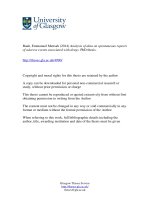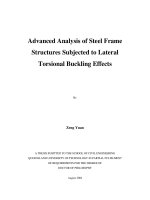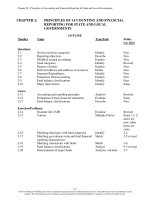group assignment analysis of steel companys financial report
Bạn đang xem bản rút gọn của tài liệu. Xem và tải ngay bản đầy đủ của tài liệu tại đây (2.03 MB, 43 trang )
<span class="text_page_counter">Trang 1</span><div class="page_container" data-page="1">
<b>GROUP ASSIGNMENTAnalysis of Steel Company’s</b>
<b>Financial Report</b>
<b>Lecturer: Tô Thụy Thùy DươngCourse: Principles of Accounting Class: IB1503</b>
<b>Group members:</b>
1. TRẦN HOÀNG BẢO QUYÊN - SS150062
3. NGUYỄN TRỌNG KHOA - SS1402304. TRẦN THỊ ANH THƯ - SS1501305. PHAN VÕ TRÚC ANH - SS1501896. NGUYỄN QUỐC KHẢI - SS150324
</div><span class="text_page_counter">Trang 2</span><div class="page_container" data-page="2"><b>ARCH 23, 2021</b>
</div><span class="text_page_counter">Trang 3</span><div class="page_container" data-page="3">I.
<b>Introductions of selected companies</b>
1. TNB- Vnsteel - Nha Be Steel Joint Stock Company2. CBI- Cao Bang Iron and Steel Joint Stock Company3. T DS- Thu Duc - Vnsteel Steel Joint Stock Company II.
<b>Data Analysis</b>
<b>C. Solvency Ratio</b>
1. Debt to Asset ratio2. Times interest earned ratio3. Working capital ratio
<b>D. Profitability ratios</b>
1. Return on assets2. Return on equity3. Gross margin ratio4. Profit Margin Ratio
<b>E. Market ratios</b>
1. Earnings per share2. Book value per share3. Price to earnings ratio4. Price to book ratio
<b>III. References</b>
</div><span class="text_page_counter">Trang 4</span><div class="page_container" data-page="4"><b>I. Introductions of selected companies</b>
<b>1.Vnsteel- Nha Be Steel Joint Stock Company (TNB : UPCOM)</b>
- The forerunner of Nha Be Steel Factory is Viet Thanh Company (VITHACO) built by a number of Chinese investors in 1967.
- In 1992, the Factory was renamed Nha Be Steel Factory
- On 01/01/2008, Nha Be Steel Joint Stock Company officially operated under the model of Joint Stock Company
- As of December 31, 2009, the Company was a subsidiary of Vietnam Steel Corporation.
<b>Business activities:</b>
- Steel production
- Trading in steel products and raw materials, rolling steel, materials, spare parts, equipment for steel production, construction, transportation, mechanical engineering, industry, oxygen, nitrogen, argon (including liquid)
- Purchase, sale and installation of air-conduction equipment systems
- Construction of civil, industrial, bridge and road, water supply and drainage systems, technical infrastructure works in urban areas - industrial zones.
<b>2.Cao Bang Iron and Steel Joint Stock Company </b>
- Cao Bang Iron and Steel Joint Stock Company was established under DecisionNo. 2155 / QD-HĐQT October 5, 2006 of the Board of Directors of Vietnam Coal - Mineral Industry Group with the main business activity of manufacturing.
- Iron ore is mined at Na Rua iron mine, Tan Giang ward, Cao Bang town, Cao Bang province.
<b>Business activities:</b>
- Provide all kinds of iron and steel, services related to mining, exploration, refining and mineral processing, ...
- Mine design consultancy, investment consultancy, mining, refining and processing all kinds of minerals;
- Consulting, technology transfer in the fields of geology, mining and metallurgy;
<b>3.Thu Duc - Vnsteel Steel Joint Stock Company (UpCOM)</b>
</div><span class="text_page_counter">Trang 5</span><div class="page_container" data-page="5">- Thu Duc Steel Joint Stock Company has its origins in the 1960s with the original name Vietnam Metal Company - VI KIMCO, operated and managed by a Vietnamese owner.
- On July 27, 1988, VIKIMCO Steel Rolling Factorychanged its name to Thu Duc Steel Factory.
- From April 15, 2016: Thu Duc Steel Joint StockCompany officially changed its name to Steel - VnsteelJoint Stock Company
<b>Business activities:</b>
- Manufacturing, trading, importing and exporting steel and steel products; raw materials and fuels, metal scrap for steel production; materials, equipment and spare parts for steel production, construction, transportation, mechanical engineering, industry.
- Manufacture and sale of construction materials.
- Producing and trading in oxygen, nitrogen, and argon in gas and liquid form; purchase, sale and installation of gas production and use equipment systems.
- Port operation business.
- Forwarding services, transporting goods, warehouse and factory rental services.
- Construction and business of high-rise buildings, offices and houses.
<b>II. Data Analysis</b>
b. Formula
Current ratio =
c.Data from selected companies
</div><span class="text_page_counter">Trang 7</span><div class="page_container" data-page="7">2018 2019 20200.00
<small>1.430.66</small>
</div><span class="text_page_counter">Trang 9</span><div class="page_container" data-page="9"><b>d. Chart 2: Acid- test ratio</b>
0.000000.500001.000001.500002.000002.500003.000003.500004.00000
</div><span class="text_page_counter">Trang 10</span><div class="page_container" data-page="10">efficiency of capital use. And we can see that CBI had an acid- test ratio under 0,5, it will not be able to pay all the short-term immediately and the enterprise may have to sell goods and assets urgently to repay the debt.
<b>B. Activity ratios</b>
<b>1. Account receivable turnover ratio</b>
The Accounts Receivable Turnover ratio provides useful information for evaluating how efficientmanagement has been in granting credit to produce revenue. It is calculated as Net Sales divided by Average Accounts Receivable.
<b>Account Receivable Turnover ratio</b><small> = </small>
</div><span class="text_page_counter">Trang 12</span><div class="page_container" data-page="12">In this chart, we can see that:
- The company with high receivables turnover ratio is CBI, whereas the lowest is TNB
- Receivables turnover ratio of CBI and TNB is increased over time, whereas TDS is decreased.
- A high receivables turnover ratio can indicate that a company’s collection of accounts receivable is efficient and the company has a high proportion of quality customers that pay their debts quickly
- A low receivables turnover ratio might be due to inadequate collection process, bad credit policies, or customers that are not financially viable or creditworthy
</div><span class="text_page_counter">Trang 14</span><div class="page_container" data-page="14"><b>3. Total assets turnover ratio</b>
</div><span class="text_page_counter">Trang 15</span><div class="page_container" data-page="15">The asset turnover ratio, also known as the total asset turnover ratio, measures the efficiency with which a company uses its assets to produce sales. The asset turnover ratio formula is equal to net sales divided by the total or average assets of a company. A company with a high asset turnover ratio operates more efficiently as compared to competitors with a lower ratio.
Total assets turnover =
<b><small>Beginning balance of total assets</small></b> <small>439,061,168,792564,646,371,631535,559,690,902</small>
<b><small>Ending balance of total assets</small></b> <small>564,646,371,631535,559,690,902361,673,763,204</small>
Net Sales
Average Total Assets
</div><span class="text_page_counter">Trang 16</span><div class="page_container" data-page="16"><b><small>Total Assets Turnover</small></b>
</div><span class="text_page_counter">Trang 17</span><div class="page_container" data-page="17">For TDS, this company has a high total asset turnover and increases every year, which shows thatkeeping a high inventory turnover reduces the risk that their inventory will become unsellable due to spoilage, damage, theft, or technological obsolescence. In contrast, CBI has a low total asset turnover, which indicates that the company is not effectively using its assets to generate sales.
<b>3.Day’s sale uncollected</b>
The Days’ Sales Uncollected ratio indicates how much time is likely to pass before we receive cash receipts from credit sales. It is calculated as Accounts Receivable divided by Net Sales times 365 days.
Day’s sale uncollected = <sub>Receivable</sub><sup>Account </sup>Net Sales
x 365
</div><span class="text_page_counter">Trang 19</span><div class="page_container" data-page="19">All three companies have fluctuated over time. TNB had the largest volatility among the 3 companies. A sharp increase in Day’s Sales uncollected can cause a company serious cash flow problems. For TDS, the collection time is also very high, but gradually decreases over the years.
<b>5. Days’ Sales in inventory</b>
Days’ Sales in Inventory is a ratio that reveals how much inventory is available in terms of the number of days’sales. It is calculated as Average Inventory divided by Cost of Goods Sold multiplied by 365
Days’ Sales in Inventory =
Average Inventory
x 365
</div><span class="text_page_counter">Trang 21</span><div class="page_container" data-page="21">TNB and TDS have fluctuated over time. TNB only needs (27-35 days) to sell out its inventory, whereas TDS need (34 - 56 days).
The company with high day’s sales in Inventory is CBI (highest 142 days). Low days sales in inventory, indicates that a business is efficient, both in terms of sales performance and inventory management</div><span class="text_page_counter">Trang 22</span><div class="page_container" data-page="22">c.
<small> </small>Data from selected company
<small> </small>i.
<small> </small>Nhà Bè Company1. Data table
Total liabilities 375,630,099,283 341,447,209,385 161,959,828,563Total assets 564,646,371,631 535,559,690,902 361,673,763,204Debt to Asset ratio 0.6652484071 <sup>0.637552107</sup> <sup>0.4478064074</sup>
<small> </small>
ii.
<small> </small>Cao Bằng Company1.
<small> </small>Data Table
Total liabilities 2,396,235,068,210 2,171,942,928,746 1,767,476,486,443Total assets 2,553,263,236,435 2,195,605,688,617 1,863,069,141,891Debt to Asset ratio 0.938499029 0.9892226733 0.9486907634
iii. Thủ Đức Company1. Data table
Total liabilities 325,867,802,311 207,246,227,825 125,336,575,865Total assets 603,688,842,588 480,440,989,395 392,165,483,307Debt to Asset ratio 0.5397943101 0.431366666 0.3196012428
</div><span class="text_page_counter">Trang 23</span><div class="page_container" data-page="23">d. Charts 3: Debt to Asset ratio
- Based on the charts, we can see that:
- The company with the highest debt to asset ratio is CPI, whereas the lowest is TDS.
- The debt to asset ratio of both TDS and TNB has the tendency to decrease over the years, which positively displays the potential of the company.
- However, the debt to assets ratio of CBI has fluctuated over time.
+ When comparing the ratio between 2019 and 2020 of the companies, TNB has decreased more than CBI and TDS.
- All of the ratios are below 1, meaning that a considerable portion of assets is funded by equity,therefore a lower chance of bankruptcy.
2. Times interest earned ratio
</div><span class="text_page_counter">Trang 25</span><div class="page_container" data-page="25">b.
<small> </small>Formula
Times interest earned =
c.
<small> </small>Data from selected companiesi.
<small> </small>Nhà Bè Company
ii. Cao Bằng Company1. Data table
Earnings before interest and taxes 18,825,080,016 -133,365,408,354 71,929,895,577Interest Expense 108,982,707,861 93,123,723,311 74,661,012,851Times interest earned ratio 0.1727345593 -1.432131401 0.9634197666
iii. Thủ Đức Company1. Data table
Earnings before interest and taxes 43,306,397,634 36,769,754,602 27,232,875,303Interest Expense 3,259,185,819 3,064,730,399 790,425,564Times interest earned ratio 13.28748959 11.99771263 34.45343438
</div><span class="text_page_counter">Trang 26</span><div class="page_container" data-page="26">d. Charts 4: Times interest earned ratio
e. Conclusion:
- Based on the given charts:
- 2019: CBI has the lowest TIE rate.
- Both TNB and CBI have a slightly variable proportion of TIE over the years
- TDS holds the top position in terms of TIE rate and significantly increases in 2020
- TDS undergoes the most volatility:+ The TIE ratio increased sharply by nearly 3 times from2019 to 2020 due to a sudden decrease in interest expenses.
- TNB has slightly fluctuated in all 3 numbers over the years, but the TIE rate increased slightly when compared from 2018 to 2020.
- CBI also has slight fluctuations in income and interest expenses, but the TIE ratio will be negative in 2019.
</div><span class="text_page_counter">Trang 27</span><div class="page_container" data-page="27">→ In general, based solely on the TIE ratio, we can conclude that TDS has a very positive chance of fulfilling long-term debt, in which the CBI has a low ability to pay interest on the debt of the firm.
3. Working capital ratioa. Definition
<small> </small>- An indicator that reflects an enterprise's ability to pay its current liabilities with its current assets.
- A representation of the difference between a firm’s current assets and current liabilities.
b.
<small> </small>Formula
Working Capital Ratio =
c.
<small> </small>Data from selected companiesi.
<small> </small>Nhà Bè Company1. Data table
Current Assets 421,149,803,478 383,742,553,326 219,854,435,058Current Liabilities 375,630,099,283 333,812,721,580 153,965,226,186Working capital ratio 1.12118226 1.149574383 1.427948638
ii. Cao Bằng Company2. Data table
Current Assets 855,027,117,324 620,319,096,367 408,754,442,748Current Liabilities 1,290,147,481,065 1,304,302,353,755 1,081,009,230,842Working capital ratio 0.6627359506 0.4755945541 0.3781229902
iii. Thủ Đức Company3. Data table
Current Assets 550,074,641,327 435,088,175,797 361,838,511,803Current Liabilities 274,819,802,311 156,198,227,825 74,288,575,865
2.001582989 2.785487274 4.870715417
</div><span class="text_page_counter">Trang 28</span><div class="page_container" data-page="28">d. Charts 5: Working capital ratio
D. Profitability ratios 1. Return on assets ( ROA,%)
a. Definition :
<b>-</b> Return on assets (ROA) is a financial ratio that shows the percentage of profit a company earns in relation to its overall resources.
</div><span class="text_page_counter">Trang 29</span><div class="page_container" data-page="29"><b>d. Chart 6: Return on Assets</b>
<small>-8-6-4-202468</small>
</div><span class="text_page_counter">Trang 30</span><div class="page_container" data-page="30">e. Conclusion:
Based on chart below :
- In 2018, Thu Duc Steel Joint Stock Company had the highest rate of return on assets, Nha Be Steel Joint Stock Company ranked second. This shows that in 2018, Thu Duc company made a lot of profit from the company's current total assets
- Return on equity (ROE) is a measure of financial performance calculated by dividing net income by total equity.
- ROE is considered a measure of how effectively management is using a company’s asset
</div><span class="text_page_counter">Trang 32</span><div class="page_container" data-page="32">c. Data from Company: ( ROE,%)
VNsteel- Nha Be Steel Joint Stock Company
<sup>7,55</sup><sup>9,79</sup><sup>10,14</sup>
Cao Bang Iron and Steel Joint Stock Company<sub>11,99</sub><sub>-563,61</sub><sub>75,25</sub>
<b>d. Chart 7: Return on Equity </b>
- The ratio indicates the percentage of each dollar of revenue that the company retains as grossprofit.
</div><span class="text_page_counter">Trang 33</span><div class="page_container" data-page="33">b. Formula:
c. Data from Company:
<b>VNsteel- Nha Be Steel Joint Stock Company</b>
Total Revenue 2,115,943,847,766 1,992,762,883,791 1,904,029,112,996
<b>Cost of Goods Sold</b>
2,032,778,454,717 1,860,325,327,816 1,789,583,812,894
Gross Margin Ratio 0,039 0,066 0,06
<b>Cao Bang Iron and Steel Joint Sto</b>
<b>ck Company<sup>2018</sup><sup>2019</sup><sup>2020</sup></b>
Total Revenue 1,803,432,879,761 2,369,646,837,008 2,153,515,519,216
<b>Cost of Goods Sold</b>
1,627,798,096,534 2,375,608,470,878 1,950,587,214,591
Gross Margin Ratio 0,097 -0,0025 0,094
<b>Thu Duc-Vnsteel Joint Stock C</b>
</div><span class="text_page_counter">Trang 34</span><div class="page_container" data-page="34"><b>d. Chart 8: Gross margin ratio</b>
e. Based on the chart above:
Overall, all three companies have very stable gross margins. In particular, the company with the highest gross profit margin is Cao Bang Iron and Steel Joint Stock Company and the lowest is Thu Duc-Vnsteel Joint Stock Company.
4.Profit Margin Ratio
</div><span class="text_page_counter">Trang 35</span><div class="page_container" data-page="35">c. Data from Company:
<b>VNsteel- Nha Be Steel Joint Stock Company</b>
Net Income 14,273,903,638 18,995,200,169 20,254,444,124Net Sales 2,098,961,368,119 1,962,208,326,136 1,877,576,543,846Profit Margin Ratio 0,0068 0,0097 0,01
Cao Bang Iron and Steel Joint St
<b>Thu Duc-Vnsteel Joint Stock C</b>
</div><span class="text_page_counter">Trang 36</span><div class="page_container" data-page="36">d. Chart 9: Profit Margin ratio
<small>0</small>
Profit margin ratio
e. Conclusion
Based on the chart above:
- Thu Duc-Vnsteel Joint Stock Company has the highest profit margin among the 3 companies, and is maintaining a stable level.
- Cao Bang Iron and Steel Joint Stock Company has the lowest profit margin and is on thedecrease over time.
</div><span class="text_page_counter">Trang 37</span><div class="page_container" data-page="37"><small>1.56</small>
Earning per share
d. Conclusion
<b>-</b> Theoretically, TNB and TDS companies both achieve EPS> 1,500 Both companies' profits are good. However, in 2019, the company CBI, the EPS dropped to a negative level The company's profit in 2019had a loss of capital.
<b>-</b> TNB's EPS ratio remains stable and increases over the years (though only a small increase compared to the ideal growth index) TNB's profitability is the best among 3 companies.
<b>-</b> In 2018, TDS's EPS is highest among 3 companies shareholders will benefit the most. However, after that, net income dropped, causing EPS to decline.
<b>2. Book value per share</b>
a. Definition
Reflects the amount of stockholders’ equity applicable to common shares on a per-share basis. BVPS indicates the value of a company's real assets if it immediately exits the market. BVPS is an accurate measure of the company's value, which does not change too quickly and is relatively stable. It is appropriate data to analyze for investors. That is, buying stocks at the right value to receive annual dividends rather than for speculators.
c. Formula
</div><span class="text_page_counter">Trang 38</span><div class="page_container" data-page="38">outstanding <sup>122,253,930,000</sup> <sup>122,253,930,000</sup> <sup>122,253,930,000</sup>
<small>0.511.522.5</small>
</div><span class="text_page_counter">Trang 39</span><div class="page_container" data-page="39"><b>d. Conclusion</b>
<b>-</b> TDS has the highest book value per share, but tends to decrease slightly
<b>-</b> TNB's BVPS increased steadily over the years and remained stable the real value of companiesincreased
<b>-</b> CBI has the lowest book value and is not stable, plummets in 2019 and increases in 2020 businessis facing many problems in production and business activities and it may be unreasonable to invest inshares of this business.
<b>3. Price to earnings ratio</b>
aaaaa. Definition
The Price Earnings Ratio (P/E Ratio) is the relationship between a company’s stock price and earnings per share (EPS). It is a popular ratio that gives investors a better sense of the value of the company. The P/E ratio shows the expectations of the market and is the price you must pay per unit of current earnings (or future earnings, as the casemay be).
</div>








